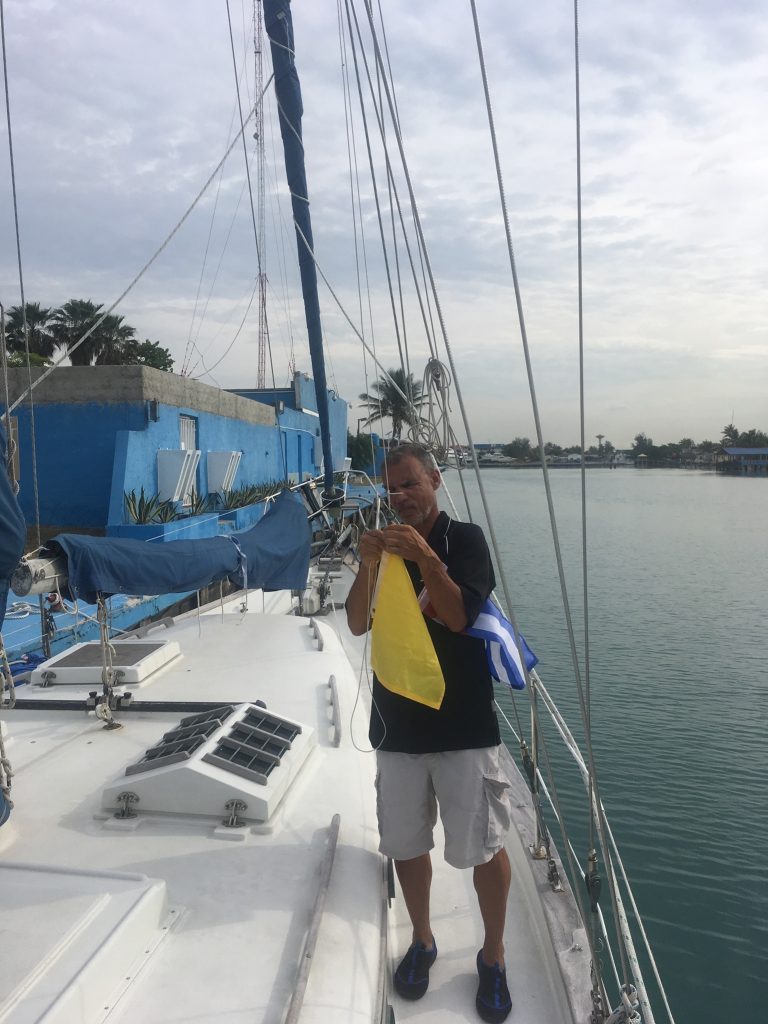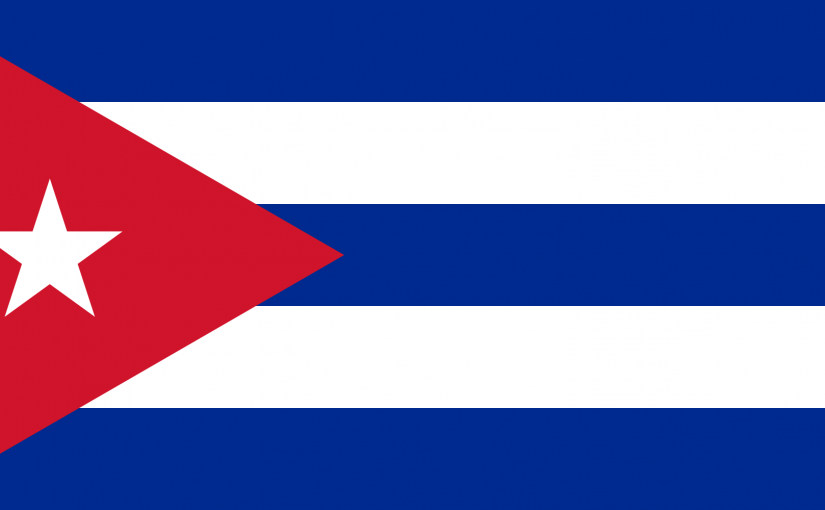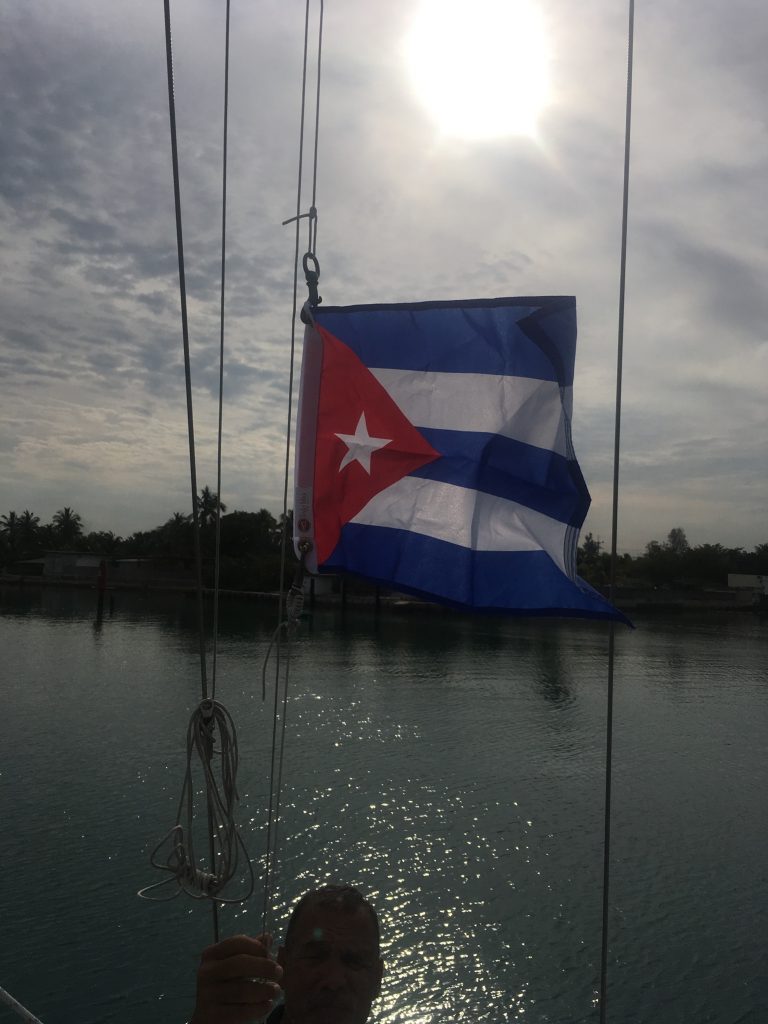So, the Coast Guard sent you the approval email…..how exciting !!! But now what ???
Don’t forget the clock is ticking and you probably only have a week, or less, before your approved departure date arrives.
Our courtesy flag flying !!
Hopefully, by the time the email arrives you will already have a Quarantine flag, a Cuban courtesy flag, a cruising guide or two, (I had read our cruising guide once or twice before we even applied) and charts. If not, you can order them here…..

In addition, you should have an appropriate supply of spare parts, provisions and done some sort of shakedown trip to bebug any known or unknown issues you might have. You can buy food in Cuba but it’s more fun to explore and try out the local spots than to have to shop, parts would be VERY difficult….parts from the US would be almost impossible.
First things first…..start checking the weather…..this will be the most limiting factor for your passage and may force you to adjust your departure date with the USCG, so watch it closely. Before we left for Cuba we met a nice gentleman in a local Marathon bar. We overheard him say he owned a Hunter 35 (which was the same model Mike previously owned) so a boat conversation promptly erupted. He asked where we here headed and we said “Hopefully Cuba!!” He said he planned to leave for Cuba and keep going south as his boat was his only possession and he had no family to keep him in the states. Since he didn’t plan on returning he wasn’t going to bother getting a permit from the Coast Guard. He planned to leave near the end of March and we told him we would see him there.
Once we arrived in Cuba there was an extended period of moderately heavy to heavy North wind. It was so bad that the St. Pete to Havana race was almost cancelled. They delayed the start of the race by a day and a record was set in the spinnaker class for completion of the trip. That boat shaved about seven hours off the old record if that gives you any idea what the winds were like.
Once the North winds exceed 15 knots for a certain amount of time the Hemingway Marina stops allowing boats to enter or exit as it becomes quite hazardous. The entry channel is bordered by shallow rocks on either side and between the countercurrents from the Gulfstream (which at the time was very close to the north shore of Cuba) and the wind it can be difficult to avoid broaching (being turned sideways from wind and waves on the stern) and crashing into the rocks. Plus the North shore of Cuba is mostly Reef, rocks and shoals, then add to that, the depth goes from 1000′ to about 50′ in less than half a mile and it can be very dicey.
After the St. Pete racers arrived and departed the North winds again increased. We heard a story about a sailboat that had apparently exited the Gulfstream to the east of the marina channel and had attempted to work it’s way back West along the shoreline to the channel. The winds had again become pretty heavy, the swells out of the North were still very strong, the boat was unable to sail or power away and the boat was pushed up onto the Reef. Upon returning to Marathon in the Florida Keys we learned that it was the man we had met in the bar just before we left. His boat had been trapped on the Reef for a few days and then a series of heavier swells had pushed it into a deeper pocket between the outer and the inner Reef. Unfortunately, there isn’t a channel or passage out of this area so his boat was damaged and then trapped in a pocket of deep water inside the two Reef areas. We haven’t heard anymore updates but it seems his boat will be a complete loss. Even if he had insurance, American based insurance companies offer no coverage in Cuba. Until March of 2019, two companies had offered special riders for Cuba coverage but they ceased to offer that citing “declining diplomatic relations”. Just before we departed Cuba, a second boat, a catamaran enroute to Key West from Mexico, was forced into Havana harbor by rough seas and high winds and later relocated to Marina Hemingway once the winds subsided. So, it’s weather, weather, weather….and make sure your engine and drivetrain are up to the challenge should you end up with a Lee shore and need the power to make a getaway.
You hear a lot of odd stories about what to take to Cuba if you’re interested in giving gifts away. We have heard people say that “hygiene products” were popular gifts as they are difficult to obtain in Cuba….or some sort of perfumes or other toiletries for women were in demand……..we didn’t see, or hear of, that. Some of those stories also came with sort of an underlying, unseemly motive for those types of “gifts”, so avoid that.
Cuba has changed quite a bit. Cellphones and social media are common. Personal items may be slightly more expensive but are readily available. Wifi, while usually available at parks or restaurants by the hour, isn’t overly common at residences. Even at a park or other location with wifi you have to buy a wifi card and then it’s $1.50 CUC (the tourist currency) for an hour of usage. Funny side note…most Cubans pronounce it “wee-fee” so the traditional pronunciation can lead to some confused looks.
I asked a few people we befriended if there were any items that we, as Americans, might take for granted that were difficult to obtain in Cuba today and they said no. What we did find was that American products that don’t get imported to Cuba are interesting as a novelty. We took a few extra bottles of bourbon which we gave as gifts to some people, a case of Budweiser we traded for a case of Cristal beer and we had some baseball shirts and extra hats on board that we gave away to some of the people we met who had kids involved in baseball. They were very grateful for the gifts as they love American sports teams in Cuba.
this one’s for Barb Lienhard ….Happy Birthday !!!
There’s also a lot of talk about what kind of currency to take with you. People often exchange US dollars for Euros in the states to avoid some of the penalties charged at official outlets when exchanging US currency. Save your time and just take US dollars. You can tip in USD until you get your exchange finished. Take plenty of $5’s for the tips. Customs and Immigration won’t ask for a tip, or expect one, but the dockmaster, the electrician (who has to connect your shorepower), the agriculture officer and the health inspector will all say “the fee is $X and if you’d like to include a gift we would appreciate it”. Plenty of people laugh at them and give nothing but the goodwill was well worth the small price. We got plenty of visits from people asking if we wanted or needed anything and we saved about $300 on the stuff we bought to bring back (rum and cigars). In the next post we will tell you where to go to get the best exchange rates, pay 0 penalty AND get a better rate. Plus if you go to the right spots to eat you’ll be paying the lesser amount for food in pesos which is $1USD to $25CUP (the locals currency) as opposed to $.90 USD to $1CUC. Three of us had lunch and beers one day at a local place for $8USD.
What about the language barrier? English is taught in Cuban schools, but like any second language taught anywhere, if it goes unused it is lost. A lot of Cubans in the marina area speak English very well. Download an English to Spanish dictionary to your phone, buy a copy of Spanish for Cruisers and learn some key phrases. Almost every menu is in Spanish….it helps to know what Cerdo, a chuleta and a pescadore are and how to get directions helps……We made some cheat sheets to review and assist the crew. I had a few years of Spanish in high school and fortunately a lot of it stuck with me…comprehension is easier and after a few days I can carry out a decent conversation.
Last, but not least, is route planning. Hopefully, you’ll have moderate east or west winds, we had light south winds, in between bouts of heavy north winds, so we ended up motoring the whole way. If you have the time, or the inclination, I would go as far West as you can before leaving the Keys. If your weather window is big enough, go to Dry Tortugas for a day or two. There’s a blog post for Dry Tortugas for any newbies. That way you will already have made some distance to the west and then join the flow of the Gulfstream, rather than fighting it, and make your final part of the ride smoother and faster. When we left, we left from Key West and we planned to turn at N24.95.840/W082.34.186 to a course of 177 degrees T and then end up about 6 miles east of the Marina entrance, turning back along the coast outside of the Gulfstream. Once we got out there the Gulfstream was further south so we got an extra ten miles West before turning south and were able to head straight for the marina entrance avoiding the risks of the north shore arrival and subsequent westerly backtrack. The Gulfstream was VERY close to the north coast of Cuba at that time. It was about a 25 hour crossing.
Next time…..how to get the “hook up” in Cuba for currency exchange, tours, rum, cigars and more…….
Auto Amazon Links: No products found.


